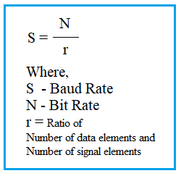
Bit Rate vs. Baud Rate: Key Differences in Data Communication
Understand the difference between bit rate and baud rate in data communication, including formulas, units, and their relationship to bandwidth and data transmission speed.
Showing 20 posts (Page 2 of 6)
Advertisement

Understand the difference between bit rate and baud rate in data communication, including formulas, units, and their relationship to bandwidth and data transmission speed.

Explore the fundamental differences between bits and symbols in data communication, including their format, usage, measurement units, and applications.
Understand the distinctions between broadband and baseband LANs, focusing on data transmission, complexity, cost, and application suitability.
Explore the key differences between Constant Bit Rate (CBR) and Variable Bit Rate (VBR) encoding methods, including their ideal use cases.
Character stuffing and bit stuffing are crucial data communication techniques that prevent control characters/bits from being misinterpreted as data. Learn the differences and examples.

A breakdown of circuit switching (CS) and packet switching (PS) in telecommunications, highlighting their differences and applications in voice and data networks.

Compare COAP and MQTT protocols for IoT: features, communication models, transport layers, security, and suitability for LLNs.

Explore the fundamentals of communication systems in electronics, covering types, components, and applications in wireless and wired technologies.
Explore a detailed glossary of RF and wireless communication terms, covering key concepts in radio frequency, DSP, and data communication for beginners and experts.

Explore the differences between copper and fiber optic cables for data communication, including their advantages, disadvantages, and applications.

Explore the benefits and drawbacks of using copper wire for data transmission compared to alternatives like fiber optics. Learn about cost, bandwidth, security, and more.
Explore the fundamental differences between data and voice communication, including connection setup, error handling, and bandwidth requirements.
Prepare for your software engineering job interview with these frequently asked questions on data communication, covering OSI model, TCP/IP, security, and emerging trends.
Explore the relationship between data speed and channel bandwidth in data communication. Understand how factors like noise and modulation levels impact channel capacity.

Explore the fundamental differences between data and signals in data communication. Learn how data is transformed into signals for transmission.

Explore the benefits of DOCSIS 3.1 and DOCSIS 4.0 standards, including speed, efficiency, security, and application suitability for modern internet needs.

Explore the differences between DPSK and BPSK modulation techniques, including information representation, sensitivity to phase variations, and applications.

Learn the key differences between Data Terminal Equipment (DTE) and Data Circuit-Terminating Equipment (DCE) in communication networks, their roles, and examples.
The E-carrier system is a non-synchronous PDH, comprising E0, E1, E2, E3, and E4, each offering different digital bit rates and channel capacities. Learn the essentials.

Explore EC-GSM IoT, a Low Power Wide Area (LPWA) technology for IoT, including its features, applications, benefits, and compatibility with GSM networks.
Advertisement